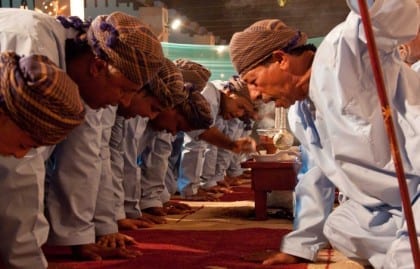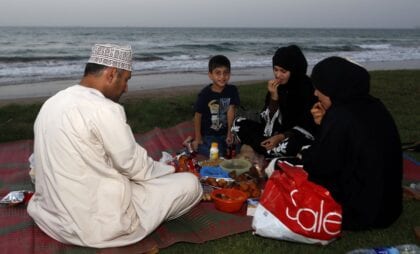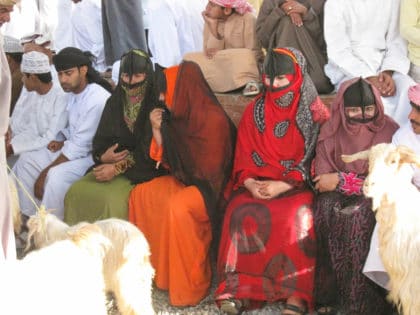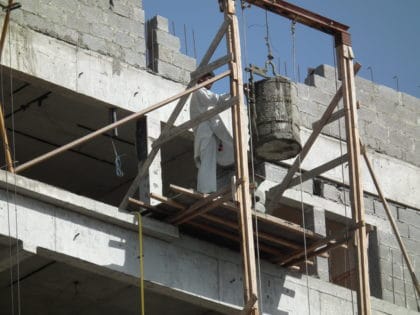
Introduction
In the past decades, Oman’s society faced radical upheaval, as did the rest of the Gulf region. Of course, change was profounder in urban areas compared to the rural regions. An extremely traditional society has become far more international in outlook. With the oil and gas revenues, Oman has managed to develop a remarkable material and immaterial infrastructure.
Imbalances
Modernization and economic development have benefited the society and country at large. However, they have also caused imbalances. For example, a division looms between the capital area and other regions. Despite attempts to invest heavily in regional development since the 4th Five-Year Plan, the capital area still draws large numbers of people. Jobs in the public sector, business opportunities and other pulls such as large shopping malls, trendy commodities and a different lifestyle attract people to the capital area, even though the cost of living is much higher there.
Already in the 1990s, some 20,000 people from al-Sharqiya (representing about 26 percent of regional inhabitants between 15-65 years) were working and living, often on a temporary basis, in the capital area. Many invite their families to live with them in the capital area. However, a majority of young men and an increasing number of women still commute on a daily (if distance allows), weekly or monthly basis.
The impact of this internal migration is profound in all spheres of regional life. On weekdays, the women and older men mainly fulfil their daily tasks in the house, the garden, the date groves, and in the community. They take care of the children, feed and herd the animals, cultivate the crops, organize the souks (markets) and many other economic and social activities. Immigrant labourers assist them in their work. However, the absence of a large number of active (male) workers affects traditional activities such as farming, fishing, crafts, and trade. In the absence of Omanis, foreigners perform this work as cheap labourers.
Internal migration received full attention in the 6th Five-Year Plan. The government has been trying to reverse the trend through decentralization of administrative functions, investments and subsidies for traditional activities. But the topic moved to the background in the 7th and 8th Five-Year Plan (2011-2015).
Family
In Omani society the average family (household) totals 7.5 people (for the usually incomplete expatriate family this figure is 4.1)
In 2003, the average Omani household size was 9 (NCSI).The Omani family usually includes three generations in one household. However, there is a trend amongst the youngest generation to leave the family compound and build their own houses, even in rural areas. This is a result of various factors such as increasing income, work opportunities outside the own village, a desire for independence and other personal motives.
Responsibility for the care of young children is entrusted to women. After the age of seven, boys increasingly fall under paternal authority, while the upbringing of daughters continues under the supervision of the mother.
A household survey conducted in 2003 indicated that women headed 7 percent of families as a result of widowhood, divorce or other factors. Expenditures were almost identical to families headed by men.
Women

Omani women have always played an important role in traditional society and economy. Modern developments in Oman have contributed to gender equality. Females and males enjoy the same level of life expectancy and education. In modern society, the female economic participation rate is increasing rapidly, from 8.6 percent in 1993 to 29.6 percent in 2011.
The main causes of women’s ascendancy in the economy are increased education, changing attitudes in society, changing consumption patterns and the need to improve family income. Age is also a factor. More young women are choosing to work. Over two-thirds of women employed in the private sector are between 20 and 29 years of age. They predominantly opt for the sectors of financial brokerage and real estate services. A positive relationship exists between economic participation rates and educational status.
Women in the public sector
In the public sector, women held 47 percent of the positions in 2012 (NCSI). There is a preference for jobs in the education sector, with an increasing interest in the health sector. In the ranks of senior government positions, two women hold positions at the ministerial level, one at the undersecretary level and two at ambassadorial level. Four hold senior advisory positions, thirteen in Special Grade, and 261 in Grade One (equivalent to Director & Director General). Five female lawyers were recently appointed as attorney generals to the legislative court. Moreover, a law providing women equal rights to own housing property ensured gender equality for women.
Equal opportunities
Since 1994, Omani women are allowed to run for election. All present laws and regulations propagate equal opportunities for women. For example, maternity leave before and after birth is set at fifty fully paid days. Mothers who return to work while continuing to breast feed are permitted to leave work an hour earlier for six months. Women also have the right to unpaid leave for twelve months after having given birth. The Islamic Sharia personal law allows women to provide for the right to divorce in marriage contracts. It is also customary in Arab societies that earnings of women accrue to their own wealth.
The National Health Survey (NHS, 2000) interviewed women about their freedom of movement. 30 percent of the women said they enjoyed total freedom. Freedom of movement significantly increases with age. Results of the survey also indicated that women’s empowerment is directly linked to their level of education. The higher the education, the more decision power and freedom of movement women have. Women tend to pursue higher education levels before marriage, as a result of which marriage is often postponed. In 1993, 52 percent of girls between fifteen and twenty years were married. In 2003, this number was just 4.2 percent. (Gender Index).
Within the family, women have significant authority and make strong contributions. However, although women enjoy equal rights in education and employment, they participate less in public life. The government subsequently launched the 2010 OMANIWOMEN campaign in acknowledgement and celebration of Omani women’s achievements and in order to increase awareness of their oppurtunities. But there are signs that women are still being discriminated when it comes to legal and social issues and that equality only applies to Omani women, not to foreign workers.
Youth
Oman has a young population: 50 percent is under 25 years of age. The youth in the age group between 15-24, represents 23 percent of the total Omani population. A new generation has been brought up in a rapidly modernizing society and booming economy. The total number of pupils enrolled in secondary school increased dramatically from 68,852 in 1995 to 129,471 in 2004. However, 60 percent leave school or drop out at primary or intermediate level. At secondary level this is 35 percent.
In general, young Omanis support the modern developments, forging new attitudes towards traditional customs, girls even more so than boys. For example, boys consider the appropriate for marriage to be 22.9 years for men and 20 for women, whereas girls consider this to be 23.7 for men and 21.4 years for women. Girls consider the average ideal family size to be 4.3 people, whereas boys 5.5. A majority of both boys and girls support the use of contraceptives.
The minimum age for employment in Oman is fifteen years. For certain hazardous occupations the minimum age is eighteen years. Youth from fifteen to eighteen years are only permitted to work six hours a day, and no more than four consecutive hours without a break.
Legal System
Oman’s legal system is based on English common law and Islamic law, with ultimate appeal to the monarch. The 1996 Basic Charter affirms the independence of the judiciary. However, in practice, the various courts are subordinate to the Sultan and subject to his influence. All judges are appointed by the Sultan, who also acts as a court of final appeal and intercedes in special cases, such as those concerning national security. However, to date, the Sultan has refrained from overturning a decision of the magistrate or commercial courts.
The Ministry of Justice administers all courts. The judiciary includes the magistrate courts, which adjudicate misdemeanours and criminal cases, the Sharia (Islamic law) courts, which adjudicate personal status cases such as divorce and inheritance, and the commercial courts. The Labour Welfare Board attempts to mediate disputes between employers and employees. If the parties cannot reach a settlement, they may seek recourse in the appropriate courts.
Magistrate court system
The magistrate court system was established by royal decree in 1984 to take over all criminal cases from the Sharia courts. It is not independent; its President reports directly to the Sultan. Regional courts of first instance handle misdemeanour cases, which are heard by individual judges.
All felonies are adjudicated at the Central Magistrate Court in Muscat by a panel made up of the President of the Magistrate Court and two judges. All rulings of the felony panel are final except for those in which the defendant is sentenced to death. The death penalty is seldom applied, mostly in rulings concerning serious crimes such as murder; the Sultan must approve death sentences. The death penalty has not been implemented since 2001.
The Criminal Appeals Panel is also presided over by the President of the Magistrate Court in Muscat and includes the court’s Vice-president and two judges. This panel hears appeals of rulings by courts of first instance.
Criminal procedures
The Criminal Code does not specify the rights of the accused. There are no written rules of evidence, codified procedures for entering cases into the criminal system, or any legal provision for a public trial. Criminal procedures developed through tradition and precedents in the magistrate courts. In criminal cases, the police provide defendants with the written charges against them.
Defendants are presumed innocent and have the right to present evidence and confront witnesses. The prosecution and the defence direct questions to witnesses through the judge, who is usually the only person to question witnesses directly in court. A detainee may hire an attorney, but has no explicit right to be represented by counsel.
Legal representation
The 1996 Basic Charter affirms both the right to counsel and government-funded legal representation for indigents. However, these provisions have yet to be implemented, and the government does not fund legal representation. Judges often pronounce the verdict and sentence within a day of the completion of a trial. Those convicted may appeal against jail sentences that are longer than three months and fines exceeding an equivalent of 1,250 USD to a three-judge panel. Defendants accused of national security offences and serious felonies do not have the right of appeal.
Cases involving national security, as well as criminal cases which according to the government require expeditious action or are of a sensitive nature, are tried by the State Security Court. Defendants tried by the Security Court are not permitted to have legal representation present.
Sharia courts
The Sharia courts are administered by the Ministry of Justice. They apply Sharia law as interpreted under the Ibadi school of Islamic jurisprudence. Courts of first instance are located in each of the 59 wilayat, or governorates, and are presided over by a single judge, or qadi. Appeals of the rulings of the courts of first instance involving prison sentences of two weeks or longer, or fines higher than 260 USD must be brought before the Sharia Court of Appeals within one month.
The Authority for the Settlement of Commercial Disputes, better known as the commercial courts system, was established by royal decree in 1981 to decide all cases related to commercial matters.
Education
Since Sultan Qaboos came to power in 1970, education has been one of the spearheads of government policy. In 1970, Oman had an illiteracy rate of about 80 percent. In 2009, the overall literacy rate was 84.4 percent for adults, and 98.4 percent for people between 15 and 24 years of age. In 2009, public expenditure on education accounted for 4.5 percent of GDP, or 26 percent of total government spending.
The country has a public system that provides free education to Omani citizens up to secondary level. However, the percentage of Omanis aged 18-24 years of age in higher education is a mere 19 percent. This is relatively low in comparison to most other equally developed countries, where this percentage is between 60 and 70 percent. One of the goals is to increase this percentage to 50 percent. Pre-primary school enrolment (figures for 2007) is 19 percent, in primary schools 73 percent, in secondary schools 79 percent and in higher education 19 percent.
Higher education
Sultan Qaboos University was established in 1986 with seven colleges. Other higher educational institutes include banking, health and industrial colleges. The Higher Education Council was established by royal decree in 1998 to allow more students to receive a higher education. Both the Minister of Education and the Minister of Higher Education sit on the council.
Oman has been successful in its bid to incorporate females in the educational system. A study on learning achievements for grade 4 and grade 6 students found no significant difference in achievements among gender groups. Female students significantly outnumber males in a number of academic fields, including science. Moreover, 59 percent of students studying abroad are female.
Health
In the World Health Report 2000, Oman came top in improving health standards among its population. In 2001, the Sultanate was at the top of the World Health Organization list on health services efficiency out of 191 countries. Indeed, health indicators testify to profound achievements over the last four decades. In 1980, life expectancy was 57.5 years; this has since increased to 74.3 years.
During the same period the crude death rate, the annual number of deaths per 1,000 people, went down from 13.3 to 2.6. The infant mortality rate plummeted from 64 per 1,000 to 10.3. Even over relatively short periods of time there has been remarkable progress. In the period from 2000 to 2005, the maternal mortality rate per 10,000 live births decreased from 37.5 to 18.5.
In 1980, there were 30 hospitals in the country (whereas just two in 1970), and by 2005, the number totalled 58. The number of hospital beds per 10,000 inhabitants went up from 18.6 to 21.0, the number of doctors per 10,000 inhabitants from 5.1 to 16.7. Between 1980 and 2005, the Ministry of Health increased the pro capita expenditure with nearly 300 percent.
Contagious diseases have been successfully combated, but increasing health problems are developing as a result of new lifestyles, increased life expectancy and accidents at home or on the road. Malnourishment as a result of changes in dietary habits poses an important challenge; heart diseases and obesity are on the increase.
Latest Articles
Below are the latest articles by acclaimed journalists and academics concerning the topic ‘Society’ and ‘Oman’. These articles are posted in this country file or elsewhere on our website:











Social Protection
Oman is a social welfare state. Policies and programmes guarantee social security, wages and employment conditions, and general programmes provide goods and services subsidies. These social schemes originate from spontaneous offers of help, as dictated by conventional traditions, kinship ties, and religious customs such as zakat (alms giving, one of the Five Pillars of Islam) and endowments.
These schemes developed into a modern system with institutionalized programmes and activities. Social safety nets include the social insurance system, poverty combat programmes, housing assistance programmes, social care for special groups and welfare activities of non-governmental organizations.